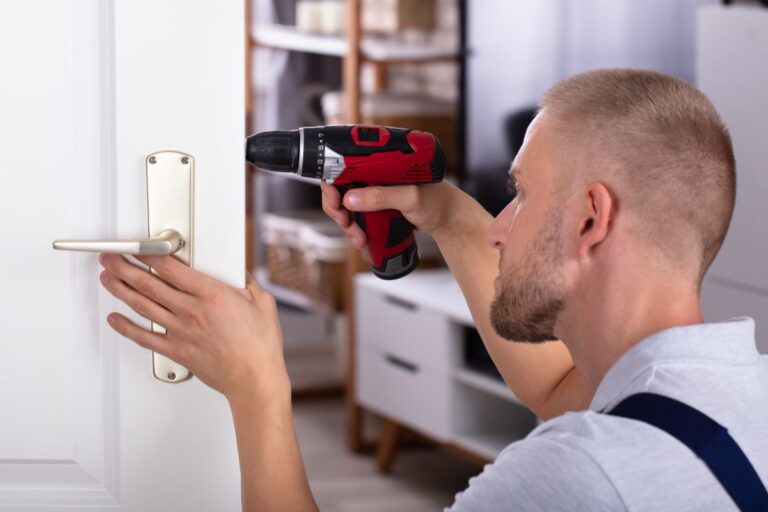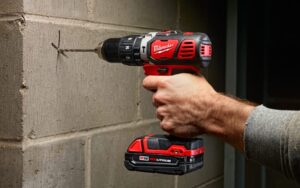Drilling out a lock should not be your first option. It is not an easy job and will require a replacement lock to be fitted afterward. You may even find that the particular lock you are using has been designed to withstand the force of a drill.
After all, a lock’s purpose is to keep you out of the property without a key.
If you are sure you have tried all other options, then drilling out the lock may be your last chance of hope. We have a simple step-by-step guide to help you drill out a lock whether it is empty or has a key stuck.
Read below to find out more!
How to drill an empty lock
Too many times have we gone out to run errands and come home only to find we have lost our keys. Or, even worse, we have left them inside the house and no windows are open!
If you have tried everything else with no luck, then it’s time to start drilling. We explain how to drill into an empty lock and gain access successfully.
Creating a guide hole
Before you go drilling aimlessly, it is important to make a guide hole in the lock. This should be between the inner and outer ring of the lock using a punch or a bradawl.
Make careful to drill your guide hole in the same direction as the key’s angular side.
Begin small & slow
Drill through the lock through the guide hole using a tiny 1/8-inch drill bit. The pins, which most locks have five of but some have six, will be destroyed as a result. Drilling ought to get harder as you approach a pin and easy as you complete that pin.
While drilling as gently as you can, be sure to keep the drill under pressure. Drilling too quickly will make it difficult to maintain the line you require and risk damaging other parts of the lock, which will make this method ineffective.
Use a larger bit size
Once you have broken all the pins you can with the ⅛-inch drill bit you are going to need to increase the size of the bit. This should be no larger than ¼-inch.
Drill back into the existing hole you have made to break the pins completely and to make opening the lock easier.
Insert a screwdriver
Turn a screwdriver in the same direction you would ordinarily turn a key by inserting it into the drilled hole. Hopefully, the lock will turn, allowing you in.
Break the lock
In the event that previous drilling and the screwdriver do not gain you access, you are going to have to destroy the lock.
Increase the bit size to ¾-inch and drill through the hill to completely destroy the lock from the inside.
How to drill a lock with a broken key

Another common event is that you are simply twisting the key inside the lock and it snaps off leaving 1 half in your hand and the other still in the lock.
This generally requires the help of a professional locksmith. However, we have a guide below to help before you do that.
Drill to the jammed key
Begin with a ¼-inch drill bit and drill into the lock cylinder until you reach the jammed key. Be careful that you are only drilling into the cylinder and not other elements of the lock.
Twist the lock
Take a screwdriver, insert it into the drilled hole and attempt to twist the lock in the direction to open the mechanism. This should open the lock and gain you access.
Remove the jammed key
At this step, you may find it beneficial to remove the jammed portion of the key to avoid causing further damage. However, there are a few methods to remove the key.
The most obvious one is to use extremely thin tweezers and to pull the key out of the lock. Or you can also use super glue.
If there is still visible metal then you can place super glue on the end of a matchstick, place the same end onto the jammed key, let it dry then pull.
Before the drill
As mentioned above, reaching for the drill to cause permanent damage to your lock should be your last option. We have a few methods that you should try before bringing out the power tools.
Picking the lock
Unlike the movies, picking a lock is a rather difficult task, even for a professional locksmith.
Try searching for lockpick videos for that specific model on Google if you know the lock’s maker and model. Use the rake lock picking technique, which is simpler to master and more effective than other approaches.
Some states have laws against lockpicks.
A bump key
A bump key was specifically designed by locksmiths for these occasions. When it is one notch short, slide it in. Once it is in position, you hit the key with a hammer, striking each of the pins.
The lock can be opened by repeatedly tapping, and if this method is going to work, it usually does so within the first dozen or so attempts.
In some states, including those where lockpicks are permitted, a bump key might not be lawful. Be careful to confirm the laws around bump keys.
A pick gun
If you are dealing with anything other than a tumbler lock then this is not an option. A pick gun releases all of the pins at once, freeing the cylinder, and allowing a tension wrench to open the lock.
A pick gun is considered a lockpick so confirm the laws before attempting.
Summary
Now, when you come home and realize you have lost your keys or your key breaks, make sure not to panic.
This simple step-by-step guide will take you through the process of how to drill out a lock. We even provide options to try before you bring out the power tools.
If all else fails it may be time to call in professional help.
Founder of HandymanGuides.com and self-proclaimed “Mr. Fix-It”, Mike has countless years of experience building and tinkering with everything under the sun. He works as a local repair guy near Santa Monica, CA and when he’s not spackling drywall, he enjoys spending time with his wife and 2 daughters.









